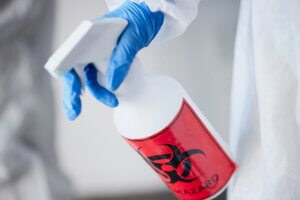BLOG

Trauma Cleaning: Steps To Restore Peace After Tragedy
Trauma Cleaning: Steps To Restore Peace After Tragedy
In the aftermath of a traumatic event, whether it be an accident, a crime or an unexpected death, the need for professional trauma cleaning services becomes paramount. Trauma cleaning is not just about tidying up; it’s a specialised process designed to ensure safety, health and peace of mind for those affected. In this article, we’ll explore the essential steps involved in trauma cleaning and how these steps help restore peace after tragedy.
Understanding Trauma Cleaning

Trauma cleaning refers to the comprehensive cleaning and sanitisation of areas affected by biohazardous materials such as blood, bodily fluids and other potentially infectious substances. This type of cleaning is crucial in preventing the spread of disease and ensuring that the affected area is safe for future use.
The Importance Of Professional Trauma Cleaning

When dealing with trauma scenes, professional trauma cleaners are essential. These experts are trained to handle biohazardous materials safely and effectively, ensuring that the area is thoroughly decontaminated. They also provide a level of sensitivity and understanding that is vital during such difficult times.
Steps To Restore Peace After Tragedy
1. Initial Assessment And Safety Protocols
The first step in trauma cleaning is a thorough assessment of the affected area. Professionals will evaluate the extent of the contamination and identify any potential hazards. Safety protocols are then established to protect the cleaning team and anyone else who might be in the vicinity. This includes the use of personal protective equipment (PPE) such as gloves, masks and protective suits.
2. Securing The Area
Once the assessment is complete, the area is secured to prevent unauthorised access. This is crucial to avoid cross-contamination and to protect the privacy of those affected. Barriers or signage may be used to indicate restricted zones.
3. Removal Of Biohazardous Materials
The next step involves the careful removal of all biohazardous materials. This includes blood, bodily fluids and any items that have been contaminated. Professionals use specialised tools and techniques to ensure that all hazardous materials are safely contained and disposed of according to health and safety regulations.
4. Cleaning And Disinfection
After the removal of biohazardous materials, the area undergoes a meticulous cleaning process. This involves the use of hospital-grade disinfectants and cleaning agents to eliminate any remaining pathogens. Every surface, nook and cranny is thoroughly cleaned to ensure that no traces of contamination remain.
5. Deodorisation
Traumatic events can leave behind strong and unpleasant odours. Professional trauma cleaners use industrial-grade deodorisers and air purifiers to eliminate these odours. This step is essential in restoring a sense of normalcy to the affected area.
6. Restoration And Repair
In some cases, trauma cleaning may involve the restoration and repair of damaged areas. This can include replacing flooring, repairing walls, or other structural repairs. The goal is to return the area to its pre-incident condition, making it safe and habitable once again.
7. Final Inspection And Clearance
Once the cleaning and restoration processes are complete, a final inspection is conducted to ensure that the area is fully decontaminated and safe. This inspection is thorough and meticulous, ensuring that no aspect of the cleaning process is overlooked. Only after this final clearance is the area considered safe for use.
8. Support And Compassion
Throughout the trauma cleaning process, professional cleaners provide support and compassion to those affected. They understand the emotional toll such events can take and strive to handle the situation with the utmost sensitivity and respect. This includes clear communication with the affected parties and addressing any concerns they may have.
9. Documentation And Compliance
Proper documentation is an integral part of trauma cleaning. Professionals maintain detailed records of the cleaning process, including the materials used, procedures followed and disposal methods. This documentation is crucial for compliance with health and safety regulations and can also be helpful for insurance purposes.
10. Follow-Up Services
Trauma cleaning services often include follow-up visits to ensure that the area remains safe and that any lingering issues are addressed promptly. This ongoing support helps to provide peace of mind to those affected, knowing that they have professionals they can rely on.
The Path To Peace And Recovery

Trauma cleaning is more than just a technical process; it’s a pathway to peace and recovery for those affected by tragic events. By ensuring that the environment is thoroughly cleaned, decontaminated and restored, professional trauma cleaners play a vital role in helping individuals and families move forward. The steps involved in trauma cleaning are essential in restoring safety, health and peace of mind after a tragedy. From the initial assessment to follow-up services, each step is designed to address the unique challenges of trauma cleaning and to provide the highest level of care and support.
If you find yourself in need of trauma cleaning services, know that there are professionals like NTCSC ready to help you through this difficult time and ensure that your environment is restored to a safe and peaceful state. Call us anytime 24/7 and find out more about our professional trauma cleaning service.